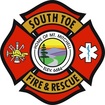Below you'll find videos and other information the Department thought might be useful to the community. Some of these videos may be graphic, and we urge viewers to use caution with younger viewers present.
Making Your Home FireWise®
The Making Your Home Firewise® video presents ideas and techniques for homeowners when constructing or modifying home in the wildland/urban interface areas. Topics covered in the video are: Roof, Windows, Eaves, Decks, and Landscaping. The video also provides information that a prevention officer or anyone with cooperative duties can use in a presentation or as a basis of discussion for various local groups.
America Burning: The Yarnell Hill Tragedy
On June 30, 2013, 19 firefighters known as the Granite Mountain Hotshots were killed battling a wildfire near Yarnell, Arizona. Huge questions remain about the last moments of their lives. Why did they move out of a safe area in their final minutes of life? Why did the fire move so quickly? Could their deaths have been prevented? The tragedy also raises a crucial environmental issue: Has the very act of fighting wildfires made our forests more dangerous? Weather.com investigates in this original documentary found below.
One Decision-Vehicular Heat Stroke
Below is a short video demonstrating the dangers of leaving a child, animal, or anyone who is incapable of defending themselves in an unattended vehicle. If you happen to see anyone trapped inside a vehicle, please call 911. It could save a life.
From One Second to the Next
Below is a video about the dangers of texting and driving. No text is that important. Make the pledge to not text and drive. It can wait.
Access and Water Supply: Fire Flow Formula
There are at least five recognized fire flow calculation methods currently in use. Some are intended for pre-incident assessment of a community’s flow rate; others are quick calculations for Incident Commanders who are faced with an emergency. The “community flow rate” calculations generally are meant for conflagration control rather than for a building fire or single room-and-contents event. The two formulas discussed below can be applied during fire size-up.
• Required fire flow (gallons per minute (gpm) = V ÷ 100.
• V = the volume of the space that is on fire.
For example, an Incident Commander arrives at a burning noncombustible mercantile occupancy that measures 50 feet by 75 feet and is 12 feet (one story) tall. The Incident Commander quickly determines that the volume of the structure is 45,000 cubic feet. Using this number and the ISU formula, the required fire flow for this structure would be 450 gpm.
(45,000 ÷ 100 = 450).
• Required fire flow (gpm) = (length x width) ÷ 3.
Using the same example, an Incident Commander arrives at a burning mercantile occupancy that measures 50 feet by 75 feet and is one story tall. The Incident Commander quickly determines that the area of the structure is 3,750 square feet. Using this number and the NFA formula, the required fire flow for this structure would be 1,250 gpm (3,750 ÷ 3 = 1,250).
- Iowa State University Method
• Required fire flow (gallons per minute (gpm) = V ÷ 100.
• V = the volume of the space that is on fire.
For example, an Incident Commander arrives at a burning noncombustible mercantile occupancy that measures 50 feet by 75 feet and is 12 feet (one story) tall. The Incident Commander quickly determines that the volume of the structure is 45,000 cubic feet. Using this number and the ISU formula, the required fire flow for this structure would be 450 gpm.
(45,000 ÷ 100 = 450).
- National Fire Academy Formula
• Required fire flow (gpm) = (length x width) ÷ 3.
Using the same example, an Incident Commander arrives at a burning mercantile occupancy that measures 50 feet by 75 feet and is one story tall. The Incident Commander quickly determines that the area of the structure is 3,750 square feet. Using this number and the NFA formula, the required fire flow for this structure would be 1,250 gpm (3,750 ÷ 3 = 1,250).
South Toe Stream Gauge
The National Weather Service have installed river gauges in rivers across the United States, which can be viewed online to check the current height of the river and what that translates to for flooding. Below you'll find the link to the NWS site where the current gauge heights can be viewed for the South Toe River gauge located near Celo, NC.
http://water.weather.gov/ahps2/hydrograph.php?wfo=gsp&gage=strn7
You'll also find RSS feeds below that lead to the current observation and alert levels of the South Toe River gauge.
Remember, if you experience floodwaters, whether driving or while at or near your home, remember.... Turn Around, Don't Drown. Immediately abandon any vehicles and move to higher ground. Call 911 to report any flooding waters.
http://water.weather.gov/ahps2/hydrograph.php?wfo=gsp&gage=strn7
You'll also find RSS feeds below that lead to the current observation and alert levels of the South Toe River gauge.
Remember, if you experience floodwaters, whether driving or while at or near your home, remember.... Turn Around, Don't Drown. Immediately abandon any vehicles and move to higher ground. Call 911 to report any flooding waters.
